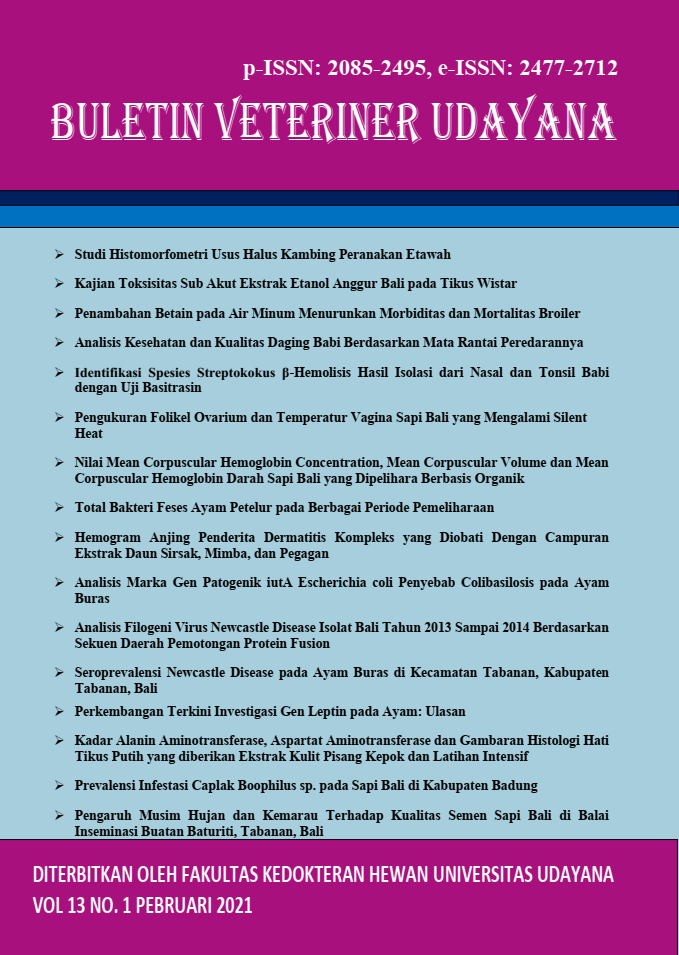HEALTH AND QUALITY ANALYSIS OF PORK BASED ON DISTRIBUTION CHAINS
Abstract
WHO states that about 75% of new diseases affecting humans in the last two decades are caused by pathogens derived from animals or animal products, so that food products of animal origin (meat) are potentially harmful to consumers. Therefore, the health and food safety aspects of animal origin (meat) need special attention. This research aimed to analyze the health and quality of pork from the abattoir/pig slaughterhouse to its circulation chain (meat stall/market). This research used a qualitative explorative method that is analyzing pig's health by inspection, palpation, and incision and the quality of pork is subjectively examined include color, aroma, consistency, and texture test, and objective test includes the test of Water Holding Capacity, Water Content, pH, and early decay. The research sample was taken from Pesanggaran and Dharmasaba abattoir and its distribution place (meat stall in Badung and Kereneng market), with 100 samples. The data of the research were analyzed qualitative descriptively. The results showed that pork from the production site to its distribution, good health. Similarly, pork from the production site (Pesanggaran abattoir and Dharmasaba) to the distribution (Badung and Kereneng market) is good. It can be concluded that pork's health and quality from production place until its distribution chains is still good, so it can be recommended healthy, safe, and feasible to be consumed.
Downloads
References
Damriyasa IM, Bauer C Nockler K, Tenter AM, Sahner H. 2000. Survey on zoonotic parasite infection s in pigs in southern Bali, Indonesia. Proc.19 Kongr. DTSCH GesParasitol, Stutgart.
Damriyasa IM, Edelhofer R, Volmer R, Bauer C, Sahner H. 2001. Curreent seroprevalence of Toxoplasma gondii infection in sows in two region of Germany. Proc. 18th Intern Conf WAAVP, Stressa/Italy. Abstract A2p. Pp. 1-8.
Dharmawan NS, Swastika K, Putra IM, Wandra T, Sutisna P, Okamoto M, Ito A. 2012. Present situation and problem of cysticercosis in animal in Bali and Papua. J. Vet. 13(2): 154-162.
Direktorat Kesmavet. 2005. Pedoman Teknis Pemeriksaan Ante-mortem dan Post-mortem di Rumah Pemotongan Hewan.Ditjen Bina Produksi Peternakan, Deptan, Jakarta Pp: 1-16.
Farghaly AM, Nada SM, Eman WA, Mattar MA, Mohammed SM, Sharaf EM, Gamal RM. 2009. Role of fast-elisa and westernblotting in diagnosis of human fascilosis using crude adult worm and excretory-secretory fasciola antigen. Parasitol. United J. 2(1): 55-65.
Forrest JC, Aberle EB, Hedrick HB, Judge MD, Merkel RA. 1975. Principles of Meat Science. W.H. Freeman and Co. San Fransisco.
Gajewska A, Smaga-Kozlowska, Wiesniewski M. 2005. Phatological changes of liver in infection of fasciola hepatica. Wiad. Parasitol. 51(2): 115-23.
Mas-Coma S, Bargues MD, Valero MA. 2005. Fasciolosis and other plant-borne trematode zoonosis. Int. J. Parasitol. 35: 1255-1265
Mendes EA, Vasconcelos AC, Lima WS. 2005. Histophatology of fasciola hepatica infection in marinos unguiculatus. Rev. Patol. Trop. 4(1): 55-62.
Pilet BD, Pouillon FM, Parizel B.2010. Fasciola hepatica infection in 65-year-old women. Radiol. Case. 4(4): 13-19.
Soeparno. 2009. Ilmu dan teknologi daging. 4thEd. Gadjah Mada University Press, Yogyakarta.
Sripa B, Kaewkes S, Intapan PM, Maleewong W, Brindly PJ. 2010. Food borne trematodoasis in southeast asia: epidemiology, pathology, clinical manifestation a control. Adv. Parasitol. 72: 305-350.
Suardana IW, Swacita IBN. 2009. Higiene makanan. Udayana Uneversity Press, Denpasar.
Swacita IBN, Damriyasa IM, Dharmawan NS, Astawa NM, Apsari IAP, Tenaya IWM. 2015a. Respons imun mecit yang diimunisasi dengan Cysticercus cellulosae. J. Vet. 16(2): 181-186.
Swacita IBN, Damriyasa IM, Dharmawan NS, Astawa NM, Apsari IAP, Oka IBM, Tenaya IWM. 2015b. Produksi dan karakterisasi antibodi monoklonal anti-Cysticercus cellulosae. J. Vet. 16(3): 325-333.
Tenter AM, Heckeroth AR, Weiss IM. 2000. Toxoplasma gondii: from Animal to Humans. Int. J. Parasitol. 30: 1217-58.
WHO. 2005. Zoonosis and Veterinay Public Health. http://www.who.int/zoonosis. Diakses tanggal 6 April 2006.





